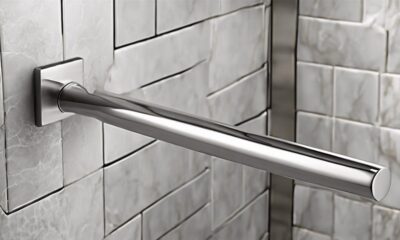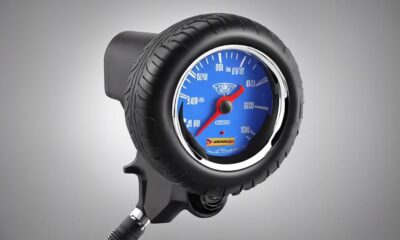Appliances
How Much Power Does a Ceiling Fan Use Compared to a Table Fan?
2025
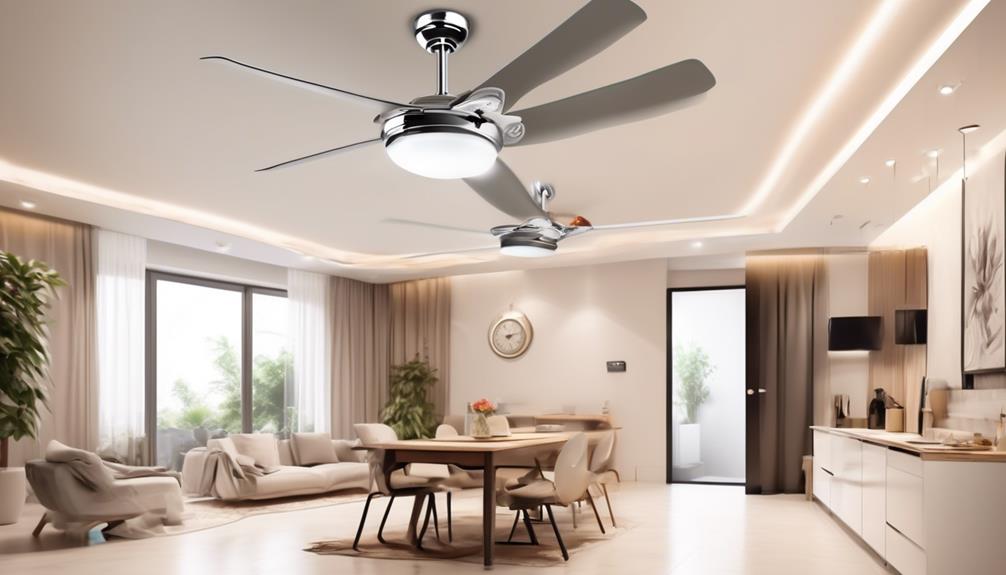
When deciding between a ceiling fan and a table fan, one key factor to consider is the amount of energy they use. It’s crucial for us to make choices that are informed and conducive to saving both energy and money.
In this article, we will explore how much power a ceiling fan uses compared to a table fan. By understanding the factors that affect fan power usage and the energy efficiency of both types of fans, we can make a more informed choice.
Additionally, we will delve into the average power usage and cost comparison between the two options. So, let's dive in and discover which fan consumes less power and provides optimal cooling while keeping our energy bills in check.
Key Takeaways
- Ceiling fans consume a significant amount of power, ranging from 10 to 120 watts, while table fans typically consume less power, ranging from 35 to 50 watts.
- Ceiling fans are more efficient for cooling larger spaces, while table fans provide localized cooling in smaller areas.
- Factors such as motor efficiency, blade design, and speed settings affect the power usage of both ceiling fans and table fans.
- Ceiling fans are more energy-efficient overall, as they are equipped with motors designed for minimal energy consumption and maximize air movement, reducing the need for air conditioning and resulting in cost savings. Table fans, on the other hand, are designed for personal use in small spaces and have lower power consumption.
Power Consumption of Ceiling Fans
Ceiling fans consume a significant amount of power, making it important to understand their power consumption for efficient energy usage. Ceiling fans are designed to move large volumes of air in a room, and this requires a certain amount of power. The power consumption of ceiling fans can vary depending on factors such as the size of the fan, the speed setting, and the efficiency of the motor. Generally, ceiling fans can consume anywhere from 10 to 120 watts of power.
It's important to note that newer models of ceiling fans are designed to be more energy-efficient, which can help to reduce power consumption. In comparison, table fans tend to consume less power than ceiling fans. Table fans typically consume around 35 to 50 watts of power. However, it's important to consider that table fans aren't designed to circulate air as effectively as ceiling fans. Therefore, if you're looking for a more efficient cooling option, a ceiling fan would be a better choice.
Power Consumption of Table Fans
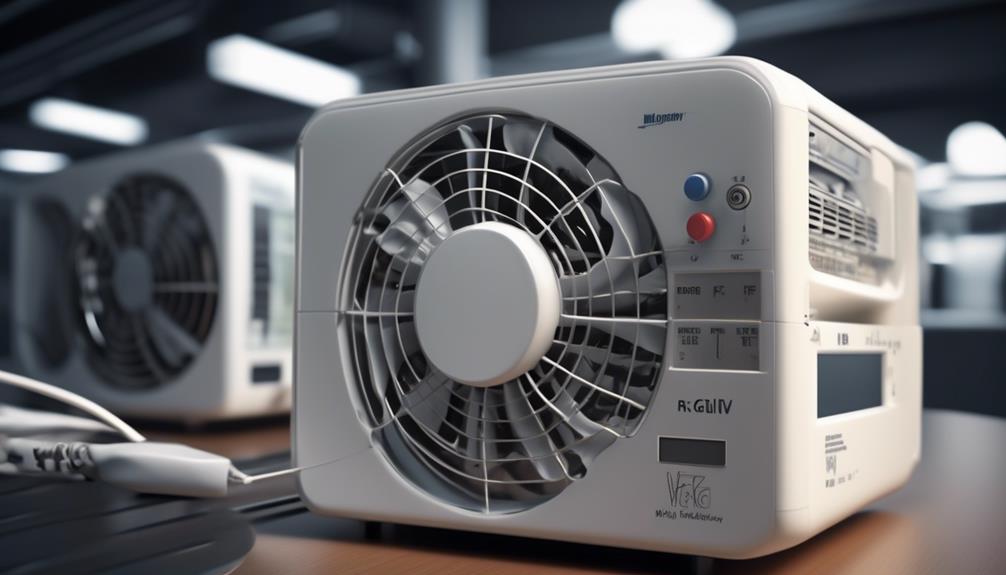
Table fans are a popular choice for providing localized cooling in homes and offices. When considering their power consumption, it's essential to understand the energy usage of these fans.
Table Fan Energy Usage
When considering the energy usage of table fans, it's important to analyze their power consumption and efficiency.
Table fans are designed to provide localized cooling in smaller spaces, such as offices or bedrooms. Their power consumption typically ranges from 25 to 75 watts, depending on the fan's size and speed settings. It's crucial to note that higher speed settings consume more power.
Additionally, table fans are generally more energy-efficient compared to other types of fans, such as ceiling fans or air conditioners. However, it's important to consider the trade-off between energy usage and cooling capacity.
Table fans may have lower cooling capacity compared to larger fans, and this can affect their effectiveness in cooling larger or more open spaces.
It's also worth noting that table fan noise levels can vary depending on the fan's design and quality.
Ceiling Fan Power Consumption
In analyzing the power consumption of ceiling fans and table fans, it's important to consider the differences in their energy usage.
When it comes to ceiling fans, the motor power plays a significant role in determining their power consumption. Ceiling fans typically have larger and more powerful motors compared to table fans, which results in higher energy usage.
However, despite their higher motor power, ceiling fans are designed to operate at lower speeds, allowing for energy savings.
On the other hand, table fans have smaller motors and are generally designed for higher speed settings, resulting in increased power consumption.
This difference in motor power and speed settings between ceiling fans and table fans highlights the importance of considering the specific needs and preferences when choosing between the two, in order to optimize energy savings.
Factors That Affect Fan Power Usage
When it comes to fan power usage, there are several factors that play a significant role.
First, motor efficiency is a key determinant as more efficient motors consume less energy.
Secondly, blade design affects the amount of air moved, with well-designed blades requiring less power.
Lastly, speed settings contribute to power usage, as higher speeds typically require more energy.
Motor Efficiency
To understand the factors that influence fan power usage, we must delve into the realm of motor efficiency. Motor efficiency refers to how effectively the motor converts electrical energy into mechanical energy to drive the fan blades. A more efficient motor requires less electricity to generate the same amount of airflow, resulting in energy savings.
Factors that affect motor efficiency include:
- Motor design: Motors with advanced designs, such as brushless DC motors, tend to be more efficient than traditional motors.
- Motor size: Smaller motors generally have lower efficiency compared to larger ones due to increased friction and heat losses.
- Motor speed control: Fans with variable speed settings allow for better motor efficiency by adjusting the motor's power consumption to match the desired airflow.
Understanding motor efficiency is crucial in maximizing energy savings and choosing the most efficient fan for your needs.
Blade Design
Blade design plays a significant role in determining the power usage of a fan. The efficiency of the blades directly affects how much energy is required to produce a certain amount of airflow.
The shape, size, and angle of the blades all contribute to their efficiency. Blades with a larger surface area can move more air with each rotation, resulting in higher blade efficiency. Additionally, blades with a steeper angle can generate more airflow at a lower speed, leading to increased blade efficiency.
Moreover, the design of the blades can affect the airflow patterns created by the fan. By optimizing the blade design to create a smooth and uniform airflow, fan manufacturers can minimize power usage while still providing effective cooling.
Understanding the impact of blade design on power usage is crucial for achieving energy-efficient fan operation.
Speed Settings
The speed settings of a fan are a significant factor that influences its power usage.
When a fan is set to a higher speed, the motor speed increases, resulting in more power consumption. On the other hand, when the fan is set to a lower speed, the motor speed decreases, leading to lower power usage.
This is because the motor needs to work harder to rotate the blades at a higher speed, consuming more energy in the process.
In terms of energy efficiency, fans with variable speed settings are more efficient compared to those with fixed speed settings. Variable speed fans allow users to adjust the speed according to their needs, reducing power consumption when lower airflow is sufficient.
Additionally, the use of energy-efficient motors can further enhance the energy efficiency of fans.
Energy Efficiency of Ceiling Fans
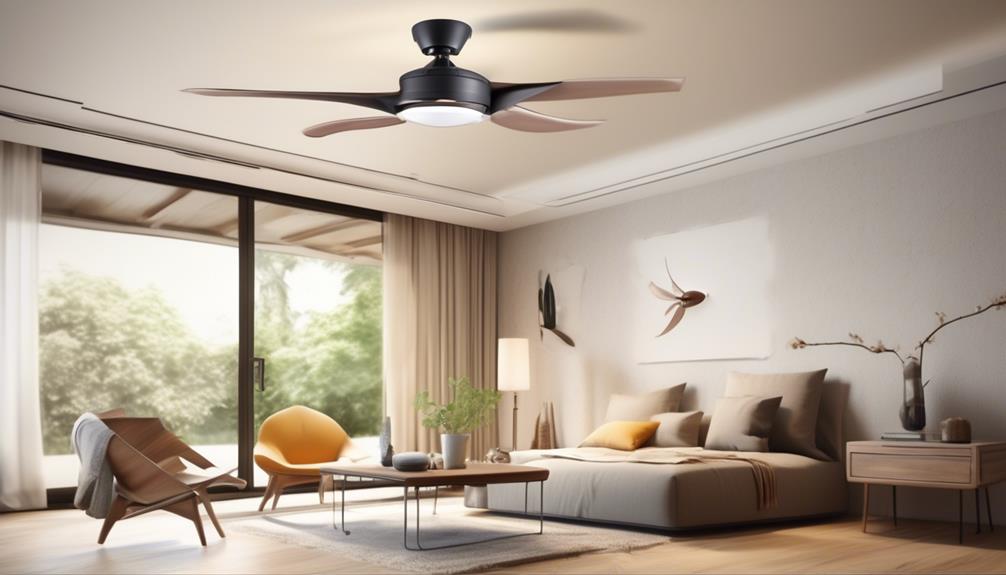
Ceiling fans are highly energy efficient due to their ability to circulate air effectively and reduce the need for air conditioning, making them a cost-effective cooling solution for homes and offices.
One of the key factors contributing to the energy efficiency of ceiling fans is the motor efficiency. Ceiling fans are equipped with motors that are specifically designed to consume minimal energy while providing maximum air movement. These motors are engineered to operate at high efficiency levels, converting electrical energy into mechanical energy with minimal losses. This ensures that the energy consumed by the motor is utilized effectively in rotating the fan blades, resulting in efficient air circulation.
Another important aspect that contributes to the energy efficiency of ceiling fans is the blade design. The shape and angle of the blades are optimized to create a downward airflow, effectively circulating the air in the room. By moving the air in a downward direction, ceiling fans create a wind chill effect, making occupants feel cooler without actually lowering the room temperature. This allows for a reduction in the use of air conditioning systems, which consume significantly more energy.
Energy Efficiency of Table Fans
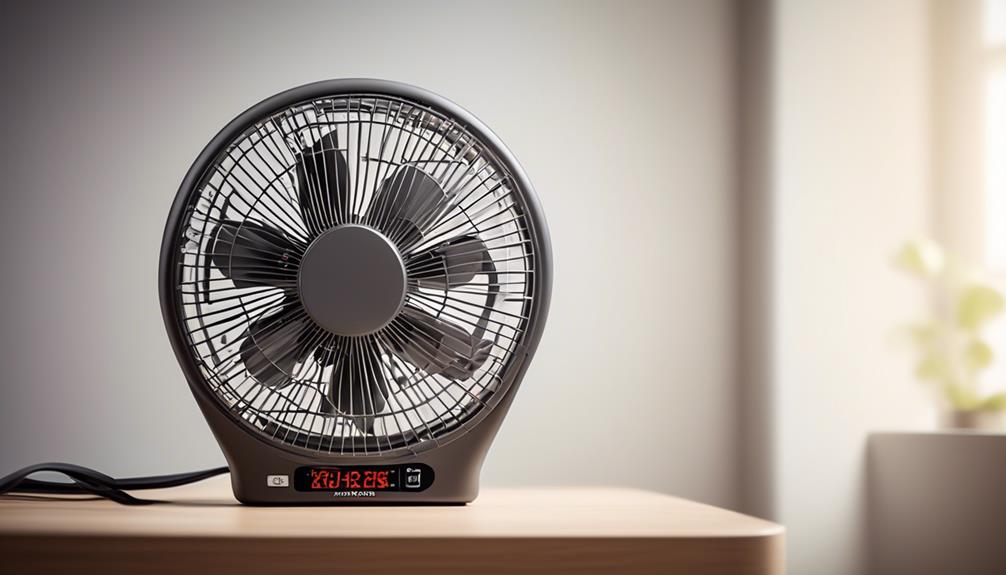
Table fans, on the other hand, offer a different level of energy efficiency compared to ceiling fans. While they may not be as powerful as ceiling fans, table fans are designed to be compact and portable, making them ideal for personal use in small spaces.
When it comes to energy efficiency, table fans have several features that contribute to their ability to save energy:
- Blade Efficiency:
Table fans are equipped with smaller blades compared to ceiling fans. These smaller blades require less power to rotate, resulting in lower energy consumption. The blades of table fans are designed to maximize airflow while minimizing resistance. This increased blade efficiency ensures that the fan can move air effectively without the need for excessive power.
- Energy Saving Technology:
Many table fans now come with energy-saving technology, such as adjustable speed settings and timer functions. These features allow users to customize the fan's operation according to their needs, saving energy in the process. Some table fans also incorporate advanced motor technology, such as brushless DC motors, which are more energy-efficient compared to traditional motors.
Average Power Usage Comparison

When comparing the average power usage of ceiling fans and table fans, it's important to consider their respective efficiency levels and energy-saving features.
Ceiling fans are generally more energy efficient than table fans, as they're designed to circulate air in larger spaces and cover a wider area. This means that ceiling fans can cool down a room more efficiently, resulting in lower average power consumption compared to table fans.
Ceiling fans typically consume an average of 15 to 90 watts of power, depending on their size, speed settings, and motor efficiency. On the other hand, table fans consume around 30 to 60 watts of power. Despite their smaller size and lower power consumption, table fans might need to run at higher speeds to achieve the same level of air circulation as ceiling fans.
To further compare the energy efficiency of ceiling fans and table fans, it's important to consider their energy-saving features. Many modern ceiling fans come equipped with features such as adjustable speed settings, timers, and even remote controls. These features allow users to optimize their energy usage by adjusting the fan's speed and duration of operation based on their needs.
Cost Comparison of Using Ceiling Fans

To accurately compare the cost of using ceiling fans, it's essential to consider several factors such as electricity rates, average usage hours, and the power consumption of the fans.
When it comes to cost savings, ceiling fans have a significant advantage over table fans. Here are some key points to consider:
- Electricity rates: Ceiling fans typically consume less power compared to table fans, resulting in lower electricity bills. This is especially true if the fans are used for extended periods or in multiple rooms.
- Average usage hours: Ceiling fans are designed to be used for longer durations, making them more cost-effective in the long run. Table fans, on the other hand, are usually used for shorter periods or in specific locations, which may not provide the same level of comfort throughout a space.
- Power consumption: Ceiling fans generally have higher power ratings than table fans, but their efficiency in circulating air allows them to deliver the same level of cooling at lower speeds. This translates to lower energy consumption and therefore reduced costs.
Considering the cost savings associated with using ceiling fans, it becomes clear that they're a more economical choice compared to table fans. Additionally, ceiling fans have a lower environmental impact as they consume less energy, contributing to reduced carbon emissions. Therefore, for those seeking cost-effective and environmentally friendly cooling solutions, ceiling fans are a wise investment.
Cost Comparison of Using Table Fans
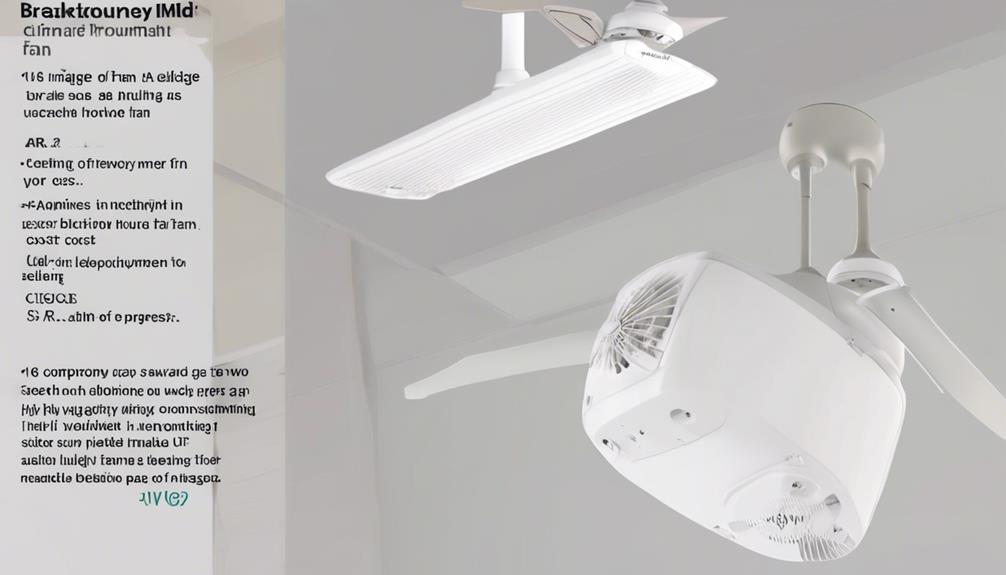
The power usage of table fans can be compared to that of ceiling fans to determine their cost effectiveness. To perform a cost analysis, it's important to consider the energy consumption of table fans. Table fans typically have lower power ratings compared to ceiling fans, ranging from 20 to 100 watts. This means that they consume less electricity while providing localized cooling.
To calculate the cost of using a table fan, we need to consider the energy consumption and the electricity rate. Let's assume a table fan with a power rating of 50 watts, and an electricity rate of $0.12 per kilowatt-hour. If the fan is used for 8 hours a day, the daily energy consumption would be (50 watts ÷ 1000) × 8 hours = 0.4 kilowatt-hours.
Multiplying the daily energy consumption by the electricity rate gives us the daily cost of using the table fan, which is 0.4 kilowatt-hours × $0.12 = $0.048.
Over the course of a month, the monthly cost of using the table fan would be approximately $0.048 × 30 days = $1.44.
In comparison, ceiling fans typically have higher power ratings and consume more electricity. However, they're designed to cool larger areas and are more energy efficient than air conditioners. Therefore, despite their higher energy consumption, ceiling fans can still be more cost-effective in terms of cooling compared to table fans.
Conclusion and Final Thoughts

Considering the cost comparison of using table fans versus ceiling fans, it's clear that while table fans have lower power usage and cost, ceiling fans can still be more cost-effective in terms of cooling larger areas. Ceiling fans typically consume more power than table fans due to their larger size and more powerful motors. However, when it comes to cooling larger spaces, ceiling fans are more efficient as they can circulate air over a wider area, providing a more comfortable environment.
Here are some final thoughts on the fan power usage and energy efficiency comparison:
- Ceiling fans may consume more power, but they're designed to cool larger areas, making them a better choice for rooms with high ceilings or open floor plans.
- They can effectively distribute cool air throughout the room, reducing the need for additional cooling devices.
- This can result in overall energy savings and lower electricity bills compared to using multiple table fans.
- Table fans, on the other hand, are more suitable for smaller spaces or targeted cooling needs.
- They're portable and can be easily moved to different locations as needed.
- Table fans are also more cost-effective for individual use or for cooling specific areas within a room.
Is the Power Consumption of a Ceiling Fan a Disadvantage Compared to a Table Fan?
When comparing the power consumption, the disadvantages of ceiling fan may not be as significant as previously thought. While ceiling fans typically consume more power than table fans, they are designed to cool larger areas and provide better air circulation, making them more energy-efficient in the long run.
Frequently Asked Questions
Can a Ceiling Fan and a Table Fan Be Used Simultaneously to Cool a Room More Efficiently?
When considering the simultaneous usage of a ceiling fan and a table fan to cool a room more efficiently, it's important to analyze their power consumption and airflow capabilities.
By strategically placing the fans in different areas of the room, we can create a more uniform and effective airflow, promoting better circulation and cooling.
However, it's crucial to note that the power usage of both fans combined will be higher than using just one fan.
Therefore, balancing energy efficiency and desired cooling effects is essential.
Are There Any Safety Concerns Associated With Using Ceiling Fans or Table Fans?
When considering the safety concerns associated with using ceiling fans or table fans, it's important to be aware of a few key maintenance tips.
Regularly inspecting the fan for any loose or damaged parts, ensuring proper installation, and keeping the fan blades clean are all essential for safe operation.
Additionally, it's crucial to avoid placing objects too close to the fan that could potentially obstruct the blades or cause a hazard.
How Does the Age or Condition of a Fan Affect Its Power Usage?
Age and condition of a fan can have a significant impact on its power usage. As fans age, they may become less efficient and require more electricity to operate.
Additionally, lack of maintenance can influence power consumption. Dust accumulation on the blades or motor can impede airflow, causing the fan to work harder and use more power.
Therefore, it's important to regularly clean and maintain fans to ensure optimal performance and energy efficiency.
Are There Any Additional Benefits to Using a Ceiling Fan or a Table Fan Besides Cooling?
When considering the use of a ceiling fan or a table fan, it's important to look beyond just cooling.
Ceiling fans not only circulate air throughout the room, providing a more even temperature distribution, but they also offer additional features such as lighting options and remote control operation.
On the other hand, table fans are more portable and can be easily moved to different areas.
It's worth noting that both ceiling fans and table fans can be energy efficient, helping to reduce electricity consumption and lower utility bills.
Can the Power Consumption of a Fan Vary Depending on Its Speed Setting?
The power consumption of a fan can indeed vary depending on its speed settings.
Higher speed settings typically require more power to generate the increased airflow, while lower speed settings consume less power.
This is due to the motor's energy requirements to spin the fan blades at different speeds.
Therefore, selecting the appropriate speed setting can help optimize power consumption and overall energy efficiency of the fan.
Conclusion
In conclusion, based on our analysis, ceiling fans generally consume more power compared to table fans. However, ceiling fans are more energy efficient in the long run, as they can effectively cool larger spaces.
One interesting statistic is that on average, a ceiling fan uses approximately 60-70 watts of power, while a table fan uses around 30-50 watts. This significant difference in power consumption highlights the importance of considering energy efficiency when choosing between these two types of fans.
- About the Author
- Latest Posts
Introducing Ron, the home decor aficionado at ByRetreat, whose passion for creating beautiful and inviting spaces is at the heart of his work. With his deep knowledge of home decor and his innate sense of style, Ron brings a wealth of expertise and a keen eye for detail to the ByRetreat team.
Ron’s love for home decor goes beyond aesthetics; he understands that our surroundings play a significant role in our overall well-being and productivity. With this in mind, Ron is dedicated to transforming remote workspaces into havens of comfort, functionality, and beauty.
Garage Door Opener
Wiring Your Liftmaster Garage Door Opener: 3 Easy Steps
Uncover the secrets to effortlessly wiring your Liftmaster garage door opener with finesse, ensuring a secure and functional setup that you won't want to miss.

Let’s discuss the important process of making sure your Liftmaster garage door opener is correctly connected with precision. By following these simple steps, you can effectively handle the wiring of your system.
Curious about how to seamlessly integrate your garage door opener into your home? Stay tuned as we navigate through the crucial steps together, demystifying the process for a secure and functional setup that you won't want to miss.
Key Takeaways
- Properly wire power supply to opener terminals for electrical connection.
- Connect control panel to opener with correct wire placement for functionality.
- Install safety sensors across from each other and connect to opener securely.
- Maintain remote control functionality and opener longevity through regular checks and lubrication.
Wiring the Power Source
To wire the power source for your Liftmaster garage door opener, connect the designated power source wires to the specified terminals on the opener, ensuring proper polarity by matching positive and negative terminals securely using a screwdriver.
Begin by identifying the power supply wires coming from the electrical outlet. Strip the insulation at the ends of the wires to expose the conductive material.
Next, locate the screw terminals on the garage door opener, usually found near the mounting bracket. Insert the positive wire into the corresponding positive terminal, ensuring a snug fit. Repeat the process for the negative wire, inserting it into the negative terminal.
Use the screwdriver to tighten the screws, securing the wires in place. Double-check the connections to guarantee no loose wires that could lead to malfunctions. Confirm the voltage requirements of the garage door opener match those of the power supply to prevent damage.
This meticulous approach ensures a safe and efficient power supply for your garage door opener.
Connecting the Control Panel

Mount the control panel of your Liftmaster garage door opener within sight of the door for convenient access and operational efficiency. When connecting the control panel, ensure proper polarity of the wires to guarantee functionality.
Here are essential steps to follow:
- Secure Mounting: Attach the control panel securely to the wall to prevent any unwanted movement during operation.
- Wiring: Run the wires from the control panel to the garage door opener and connect them to the designated terminals following the manufacturer's instructions.
- Warning Placard: Affix the warning placard near the control panel as a safety reminder for users interacting with the garage door opener.
Proper installation of the control panel is crucial for the overall performance of your Liftmaster garage door opener. By following these steps diligently, you can ensure a smooth and efficient operation of your garage door system.
Securing Safety Sensors
When securing safety sensors for your Liftmaster garage door opener, ensure precise alignment and proper wiring to guarantee optimal functionality and safety. The sensors, crucial for detecting obstacles in the path of the garage door, work by transmitting an invisible light beam.
Start by mounting the sensors across from each other on the wall, using the provided mounting brackets. It's essential to align the sensors correctly to ensure the invisible light beam path is unobstructed. Use staples to secure the sensor wiring along the wall, keeping it neat and out of the way.
When wiring, connect the sensor wires to the appropriate terminals on the Liftmaster garage door opener, following the manufacturer's safety guidelines. Remember always to disconnect the power to the opener before installation to prevent any accidents.
Frequently Asked Questions
How Do I Connect My Liftmaster Garage Door Opener?
To connect your Liftmaster garage door opener, follow these steps:
- Locate and identify the terminals on the opener connected to the wall button, typically labeled 1 and 2.
- Using a screwdriver, release the push-type terminals and securely insert the stripped ends of hookup wires.
- Connect the wires from the wall button to the designated terminals on the garage door motor unit.
- Ensure proper wire management by securing and hiding the wires to avoid interference with the door's operation.
How Many Wires Do You Need for a Garage Door Opener?
When setting up a garage door opener, we typically require a minimum of 2 wires for standard functionality. However, some advanced models might necessitate extra wires for specific features.
These wires establish the connection between the control panel/remote and the opener motor, enabling signal transmission for door operation.
Ensuring proper wiring is crucial for optimal performance of your Liftmaster garage door opener.
How Do You Wire a Push Button Garage Door Opener?
When wiring a push button garage door opener, we start by identifying the terminals on the opener that connect to the push button.
Using a screwdriver, we release and insert the stripped ends of hookup wires into the designated terminals on the motor unit.
We then ensure a secure connection by twisting and fastening the wires.
Proper wire routing is crucial to prevent interference with the garage door's operation.
How to Program the Garage Door Opener in Your Car in 3 Easy Steps?
When programming your garage door opener in your car, locate the 'Learn' button on the opener motor unit. Press and release it, then swiftly return to your car to hold the desired button for programming. Wait for the light to flash or hear two clicks to confirm.
Test the button to ensure successful programming.
These steps are essential for seamless operation of your Liftmaster system.
Conclusion
In conclusion, wiring your Liftmaster garage door opener is as simple as connecting the dots. Just like a skilled electrician effortlessly navigates a circuit board, you can confidently wire your opener with ease.
By following the three easy steps outlined, you'll have your garage door opener up and running smoothly in no time.
So, grab your tools and get ready to bring power to your garage door with precision and confidence.
- About the Author
- Latest Posts
Introducing Ron, the home decor aficionado at ByRetreat, whose passion for creating beautiful and inviting spaces is at the heart of his work. With his deep knowledge of home decor and his innate sense of style, Ron brings a wealth of expertise and a keen eye for detail to the ByRetreat team.
Ron’s love for home decor goes beyond aesthetics; he understands that our surroundings play a significant role in our overall well-being and productivity. With this in mind, Ron is dedicated to transforming remote workspaces into havens of comfort, functionality, and beauty.
Garage Door Opener
Choosing the Right Size Battery for Your Garage Door Opener
Find out why selecting the perfect battery size for your garage door opener is crucial for avoiding disruptions and ensuring smooth operation.

We’ve all experienced it – 70% of garage door opener malfunctions are caused by battery problems. Choosing the correct size battery is crucial for smooth operation.
But how do you know which battery is the perfect fit for your opener? Let's shed light on this essential aspect to keep your garage running smoothly and avoid unexpected disruptions.
Key Takeaways
- Consider manufacturer's voltage requirements for optimal performance.
- Choose the correct battery size for longer opener lifespan.
- Rechargeable batteries offer cost-effectiveness and consistent power.
- Adhere to manufacturer's recommendations for efficient operation.
Factors to Consider When Choosing Battery Size
When selecting the appropriate battery size for your garage door opener, it's crucial to carefully consider the voltage requirements specified by the manufacturer. Adhering to the manufacturer's recommendations ensures that the battery size is compatible with your garage door opener, providing the necessary power source for optimal performance. Choosing the correct battery size not only allows for efficient operation but also contributes to a longer lifespan for your garage door opener.
Opting for a rechargeable battery can be a practical choice, offering the advantage of being reusable and environmentally friendly. Rechargeable batteries provide a cost-effective solution in the long run, as they can be recharged multiple times before needing replacement. Additionally, they often have a higher capacity compared to disposable batteries, ensuring a consistent power supply to your garage door opener.
Types of Batteries for Garage Openers

For selecting the appropriate battery type for garage door openers, consideration of lithium, alkaline, and rechargeable options is essential based on their power characteristics and longevity.
When it comes to garage door opener batteries, here are the options to consider:
- Lithium Batteries: Known for their long-lasting power and reliability, lithium batteries are commonly used in garage door opener remote controls.
- Alkaline Batteries: Offering a non-rechargeable but reliable power source, alkaline batteries are another viable option for garage door openers.
- Rechargeable Batteries: Rechargeable options like nickel-cadmium (NiCd) and lithium-ion (Li-ion) provide sustainability and cost-effectiveness for long-term use in garage door openers.
- Manufacturer's Recommendations: Battery size and type depend on the specific brand and model of the garage door opener, so it's crucial to check the manufacturer's recommendations to ensure optimal performance and prevent malfunctions.
Popular Battery Brands for Openers
Among the array of battery brands available for garage door openers, Duracell stands out for its reputation of delivering enduring power and exceptional performance.
Known for their long-lasting power and reliable performance, Energizer batteries are a popular choice for various garage door opener models.
Panasonic batteries are recognized for their durability, reliability, and high energy output, making them a preferred option for many users.
Rayovac offers value for money with its combination of long-lasting performance and reliability, making it a top contender in the market of garage door opener batteries.
Eveready also provides dependable options for garage door opener batteries, ensuring consistent power and performance.
When choosing the right battery for your garage door opener, considering these popular brands can help you find the optimal balance between longevity, reliability, and performance for your specific needs.
How to Replace Garage Door Opener Battery

Having identified the specific battery type required for your garage door opener, the next step is to open the remote control cover correctly to access the battery compartment for replacement.
When replacing the battery for your garage door opener, follow these steps:
- Open the Cover: Gently slide the cover of the remote control in the direction indicated to reveal the battery compartment.
- Remove the Old Battery: Carefully take out the old battery by pushing it gently from the sides to release it from the connectors.
- Insert the New Battery: Place the new battery in the compartment, ensuring the correct orientation as per the markings inside.
- Close the Cover: Once the new battery is securely in place, slide the cover back onto the remote control until it clicks shut.
Troubleshooting Tips for Battery Issues
To troubleshoot battery issues with your garage door opener, we recommend conducting a thorough inspection of the battery compartment and connections. Start by checking the brand and model of your garage door opener remote to determine the correct battery type needed for replacement. It's crucial to use the specific battery number designated by the manufacturer to prevent compatibility problems with your garage door opener.
If necessary, refer to the owner's manual or open the transmitter to identify the exact battery required for your remote control. Pay attention to any colored smart buttons on the remote, such as yellow ones for Security+ 2.0 models, which may indicate the particular battery type needed. Always ensure the proper functioning of your garage door opener remote by using the right battery number and avoiding substitutions to prevent any potential damage.
Frequently Asked Questions
What Size Battery Does My Garage Door Opener Take?
We must ascertain the specific battery size required by your garage door opener for optimal performance.
It's crucial to identify the manufacturer-specified battery number and the type indicated by the colored smart buttons on the remote control.
Accessing the battery compartment through the proper opening of the remote control cover is essential for replacement.
Ensuring the correct battery size will guarantee seamless operation of your garage door opener.
What Battery Is Best for Garage Door Opener?
We've found that longevity is crucial when selecting the best battery for a garage door opener, with lithium batteries lasting approximately 5 years.
It's vital to match the specific battery type recommended for your transmitter to avoid compatibility issues.
Do Garage Door Openers Need Special Batteries?
Yes, garage door openers do require special batteries. These batteries, like 3-volt lithium or 12-volt options, are crucial for reliable remote operation in various settings. Having the correct battery size is essential to prevent malfunctions and ensure smooth garage door operation.
Additionally, certain keypads and remote controls may need 9-volt batteries for backup power in keyless entry systems. Selecting the right size and type of battery is vital for consistent functionality.
What Battery Do I Need for Liftmaster Garage Door Opener?
We need a CR2016 or CR2032 3-volt lithium battery for our LiftMaster garage door opener.
It's crucial to check the model specifications for the correct battery type. Proper maintenance and timely battery replacement are essential for smooth operation.
Make sure to have the right battery on hand to avoid any disruptions in functionality.
Conclusion
In conclusion, selecting the appropriate battery size for your garage door opener is imperative for optimal performance. By considering factors such as capacity, lifespan, and voltage requirements, you can ensure smooth operation.
Choosing reputable brands like Duracell or Energizer and performing regular maintenance will further enhance reliability. Remember, a well-chosen battery can make all the difference between seamless functionality and unexpected disruptions.
Choose wisely for peace of mind.
- About the Author
- Latest Posts
Introducing Ron, the home decor aficionado at ByRetreat, whose passion for creating beautiful and inviting spaces is at the heart of his work. With his deep knowledge of home decor and his innate sense of style, Ron brings a wealth of expertise and a keen eye for detail to the ByRetreat team.
Ron’s love for home decor goes beyond aesthetics; he understands that our surroundings play a significant role in our overall well-being and productivity. With this in mind, Ron is dedicated to transforming remote workspaces into havens of comfort, functionality, and beauty.
Garage Door Opener
Cost-Effective LiftMaster Garage Door Opener Options
Get ready to explore cost-effective LiftMaster garage door opener options that offer a perfect blend of affordability and functionality, unlocking hidden treasures for your garage needs.

When considering cost-effective LiftMaster garage door openers, it can feel like navigating a maze full of hidden treasures just waiting to be discovered.
From the sturdy chain drive models to the sleek belt-operated ones and the space-saving wall-mounted units, each offers a unique blend of affordability and functionality.
But how do you determine which one strikes the perfect balance between cost and features?
Let's explore the key factors that could influence your decision and help you find the ideal LiftMaster opener for your garage needs.
Key Takeaways
- LiftMaster offers cost-effective chain drive openers with myQ technology and battery back-up.
- Affordable belt drive models provide smooth, quiet operation with steel-reinforced rubber belts.
- Wall-mount openers offer space-saving solutions with WiFi connectivity and automatic door lock.
- LiftMaster openers feature built-in WiFi, various drive systems, warranties, and compatibility with accessories.
LiftMaster Chain Drive Opener Prices
Have you considered the cost-effective LiftMaster chain drive opener prices ranging from $200 to $400 for your garage door needs? When it comes to finding a reliable and smart solution for your garage, the LiftMaster Chain Drive Garage Door Opener offers a range of features at accessible prices. Equipped with myQ technology, these openers allow you to control your garage door from anywhere using your smartphone. The convenience doesn't stop there – within this price range, you can choose from various motor options to suit your specific requirements.
In addition to the advanced technology, LiftMaster chain drive openers come with valuable features such as battery back-up systems, built-in lighting for added security, and warranties for peace of mind. Whether you're looking for a basic model or one with all the bells and whistles, LiftMaster offers a range of options that cater to different budgets and preferences. Upgrade your garage door opener to a smart and efficient solution without breaking the bank.
LiftMaster Belt Drive Opener Costs

Considering the affordability of LiftMaster chain drive opener prices, let's now explore the cost-effective range of LiftMaster belt drive opener options for your garage door needs. LiftMaster belt drive garage door openers typically range from $300 to $600, with popular models falling between $375 and $425, offering a balance of quality and affordability. These openers are renowned for their smooth and quiet operation, making them perfect for homes where noise reduction is essential. The steel-reinforced rubber belt ensures durability, and extension kits are available for 8 or 10-foot doors. Customers can rely on the reliable performance of LiftMaster belt drive garage door openers, all at a reasonable price point.
| Features | Description |
|---|---|
| Smooth and Quiet Operation | Ideal for noise reduction in residential settings |
| Steel Reinforced Rubber Belt | Ensures durability and longevity |
| Reliable Performance | Consistent operation you can count on |
LiftMaster Wall-Mount Opener Options
Exploring LiftMaster wall-mount opener options reveals premium solutions ideal for high or irregular ceilings, offering advanced features for enhanced control and security. When considering LiftMaster wall-mount openers, there are several key features to keep in mind:
- Direct Drive Operation: These openers operate without belts or chains, ensuring a smooth and quiet performance.
- WiFi Connectivity and Smart Technology: Enjoy advanced control and monitoring capabilities with options for connectivity to your smart devices.
- Automatic Door Lock: Enhance security with the automatic door lock feature, providing peace of mind when away from home.
- Space-Saving Installations in Residential Settings: Designed for convenience, these openers are ideal for saving space in residential garages, making them a practical choice for any home.
With prices ranging between $500-$600, LiftMaster wall-mount openers offer a reliable and efficient solution for those looking to optimize their garage door opener in unique ceiling situations while enjoying modern conveniences and enhanced security features.
LiftMaster Opener Features Overview

When moving on to discuss the 'LiftMaster Opener Features Overview,' it becomes evident that LiftMaster garage door openers offer a range of advanced features tailored to enhance convenience and security for users.
LiftMaster garage door openers are equipped with built-in WiFi, allowing for seamless operation through smart technology. With options like belt drive and chain drive systems, users can choose the mechanism that best suits their needs. Additionally, features such as battery back-up ensure that the opener functions even during power outages, providing peace of mind.
LiftMaster Garage Door Openers also come with innovative functions like automatic door lock and lifetime warranties, adding value to the user's investment. These openers can be further enhanced with accessories such as cameras, keypads, and motion alerts, offering added convenience and security.
With prices ranging from $200 to $600, LiftMaster provides cost-effective solutions for various budgets, making them a practical choice for those seeking reliable and feature-rich garage door openers.
Garage Door Opener Buying Tips
To make an informed decision when buying a garage door opener, it's essential to consider factors such as budget, required features, and installation requirements. When shopping for a garage door opener, keep in mind the following tips:
- Types of Garage Door Openers: Explore options like chain drive models for affordability or belt-operated models for a balance of quality and cost.
- Smart Home Integration: Consider smart-enabled devices that can be controlled through the LiftMaster myQ app for added convenience.
- Installation Requirements: Evaluate whether you need a wall-mounted opener for space-saving solutions.
- Material Preferences: Decide between a metal chain or a rubber belt based on noise levels and durability.
Frequently Asked Questions
What Is the Average Price of a Liftmaster Garage Door Opener?
We found that the average price of a LiftMaster garage door opener can range between $200 to $1,000.
Basic chain drive models start around $200, while advanced belt-operated ones go up to $600.
Wall-mounted direct drive openers can cost from $400 to $800, and smart-enabled models with WiFi features may range from $400 to $1,000.
Prices vary based on horsepower, additional features, and user preferences.
What Is the Best Liftmaster Garage Door Opener for 2023?
We believe the best LiftMaster garage door opener for 2023 is the LiftMaster Wall Mount Garage Door Opener. Priced between $500-$600+, this model offers premium features like automatic door lock, WiFi, and Smart technology.
It's a top pick for homeowners seeking advanced functionalities. With its innovative design and reliable performance, the LiftMaster Wall Mount Garage Door Opener stands out as a cutting-edge choice for modern garage automation needs.
Which Is a Better Garage Door Opener Genie or Liftmaster?
When comparing Genie and LiftMaster garage door openers, we prefer LiftMaster for its durability, reliability, and advanced security features.
While Genie may seem more budget-friendly initially, LiftMaster's long-term performance and compatibility with smart home systems make it the superior choice.
For enhanced safety and convenience, LiftMaster stands out with its solid warranties and smart technology integration.
What Is the Average Life of a Liftmaster Garage Door Opener?
We've got the scoop on the average lifespan of a LiftMaster garage door opener! These durable and reliable openers typically last around 10-15 years with regular maintenance.
Proper installation and periodic servicing can even extend their longevity. Factors like usage frequency, environmental conditions, and maintenance practices play a role in how long they'll last.
Investing in a quality LiftMaster opener can be a smart choice due to its extended lifespan.
Conclusion
In conclusion, when it comes to cost-effective garage door opener options, LiftMaster offers a range of models to suit different needs and budgets.
Whether you're looking for a chain drive, belt drive, or wall-mount opener, LiftMaster has you covered with features like WiFi connectivity, Smart technology, and battery backups.
Investing in a LiftMaster opener is like having a reliable guardian for your garage, providing security and peace of mind like a trusty shield.
- About the Author
- Latest Posts
Introducing Ron, the home decor aficionado at ByRetreat, whose passion for creating beautiful and inviting spaces is at the heart of his work. With his deep knowledge of home decor and his innate sense of style, Ron brings a wealth of expertise and a keen eye for detail to the ByRetreat team.
Ron’s love for home decor goes beyond aesthetics; he understands that our surroundings play a significant role in our overall well-being and productivity. With this in mind, Ron is dedicated to transforming remote workspaces into havens of comfort, functionality, and beauty.
-

 Decor1 week ago
Decor1 week agoMaximalist Decor Explained: Embrace More Style
-

 Vetted4 weeks ago
Vetted4 weeks ago15 Best Drip Irrigation Systems to Keep Your Garden Thriving
-

 Vetted2 weeks ago
Vetted2 weeks ago15 Best Foot Massagers for Neuropathy to Soothe Your Feet and Relieve Discomfort
-

 Vetted3 weeks ago
Vetted3 weeks ago15 Best Sports Laundry Detergents for Keeping Your Activewear Fresh and Clean
-

 Vetted3 weeks ago
Vetted3 weeks ago15 Best Tall Toilets for Seniors That Combine Comfort and Safety
-

 Vetted3 weeks ago
Vetted3 weeks ago15 Best Dish Scrubbers to Keep Your Kitchen Sparkling Clean
-

 Decor3 weeks ago
Decor3 weeks agoWhat Is Eclectic Home Decor
-

 Vetted4 days ago
Vetted4 days ago15 Best Organic Pest Control Solutions for a Naturally Pest-Free Home








